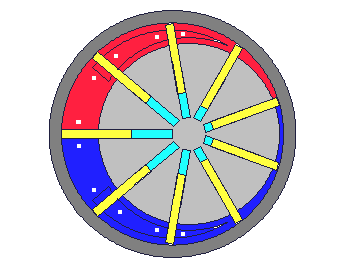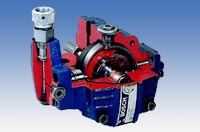

On many industrial installations with a maximum pressure of about 200 bar, vane pumps are applied. The advantage of vane pumps is the pulse free delivery and low level of noise.
The shaft of the rotor with the radial mounted vanes is driven by an engine or motor. The stator ring is circular in form and is held in an eccentric position. The amount of eccentricity determines the displacement of the pump. When the amount of eccentricity is decreased to zero, the displacement of the pump becomes 0 cm3: from that moment on the pump doesn't deliver any oil.
Suction and delivery: The chambers between the vanes rotate with the rotor. At the suction side the chamber volume increases and the chamber is filled with oil from the suction line. At the pressure side the chamber volume decreases and the oil is forced into the pressure line.
The pressure at the pressure side
is determined by the resistance in the system. The most important resistance is the load on the hydraulic cilinder or hydraulic motor.
In order to prevent cavitation, the pressure at the suction side of the pump should not exceed 0.1 to 0.2 bar (10 to 20 kPa) below atmospheric pressure (minimim absolute pressure: 0.8 bar or 80 kPa).